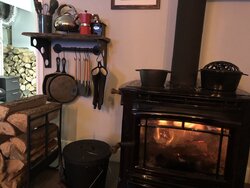Hi everyone,
I bought the Manchester and installed it at the end of november 2020 in my basement. I installed it on my old PSG external cheminey (7´´). I had to use a 6 to 7 inch fitting to plug it. Moreover i have a 7 feet horizontal line plus a 24 inch check before getting to the external chimney.
That being said, ill try to explain the custom setup i did. i have a total of 4500 sq foot on 3 level in the house with a central ventilation system. the Manchester is installed under the garage (in a kind of bunker) where i put two 6 ‘’ blowers that are connected to the central venting system. Moreover, i have a wifi thermostat that is connected to the blower which i can control with my phone to choose when the blowers start. ( i have installed an external gaz generator with a transfer switch that actually make the blowers and all other essentials work in case of blackout.)
Of course the « bunker » get hot when slow burn is engaged to heat the house up. (Up to 26-27 C*). the « bunker » is 400 sq foot. fully concrete, anti fire eurethane with shaft walls on the perimeter (anti fire walls) I use to work in drywall industrie)
So far here are the result after 2 months:
1- we used it non stop since late november except in the last week (we had mild temp north of montreal) ( i did use it 1 day out of 2)
2-since the house
somewhat big, the air at the upper level or even mid level that get out of the venting holes isnt that hot.
However, when slowburn is engaged 45 or 60 min the whole house is feeling extremly confortable on all level. its like that the ciculation of air is getting uniform and confortable after a short moment everywhere execept in the « bunker » where it can reach 26-27*C
3- a few weeks ago i had to clean the catalysts. They were jammed by creosote (black stuff all over the honeycombs). The Manchester has 2 Catalyst (rectangle) The symptom was that i couldnt use the slow burn anymore: the glass got all black and the fire just vanished.
Now its fully functional
4- I bought 4 cords of wood late summer. I had to store it all in my garage (it was wet) As of today, after 2 months, i still have almost 1 left...
5- it is my first experience with a wood stove, so far I am extremely satisfied with it.
Feel free if you have questions or comments.

I bought the Manchester and installed it at the end of november 2020 in my basement. I installed it on my old PSG external cheminey (7´´). I had to use a 6 to 7 inch fitting to plug it. Moreover i have a 7 feet horizontal line plus a 24 inch check before getting to the external chimney.
That being said, ill try to explain the custom setup i did. i have a total of 4500 sq foot on 3 level in the house with a central ventilation system. the Manchester is installed under the garage (in a kind of bunker) where i put two 6 ‘’ blowers that are connected to the central venting system. Moreover, i have a wifi thermostat that is connected to the blower which i can control with my phone to choose when the blowers start. ( i have installed an external gaz generator with a transfer switch that actually make the blowers and all other essentials work in case of blackout.)
Of course the « bunker » get hot when slow burn is engaged to heat the house up. (Up to 26-27 C*). the « bunker » is 400 sq foot. fully concrete, anti fire eurethane with shaft walls on the perimeter (anti fire walls) I use to work in drywall industrie)
So far here are the result after 2 months:
1- we used it non stop since late november except in the last week (we had mild temp north of montreal) ( i did use it 1 day out of 2)
2-since the house
somewhat big, the air at the upper level or even mid level that get out of the venting holes isnt that hot.
However, when slowburn is engaged 45 or 60 min the whole house is feeling extremly confortable on all level. its like that the ciculation of air is getting uniform and confortable after a short moment everywhere execept in the « bunker » where it can reach 26-27*C
3- a few weeks ago i had to clean the catalysts. They were jammed by creosote (black stuff all over the honeycombs). The Manchester has 2 Catalyst (rectangle) The symptom was that i couldnt use the slow burn anymore: the glass got all black and the fire just vanished.
Now its fully functional
4- I bought 4 cords of wood late summer. I had to store it all in my garage (it was wet) As of today, after 2 months, i still have almost 1 left...
5- it is my first experience with a wood stove, so far I am extremely satisfied with it.
Feel free if you have questions or comments.




